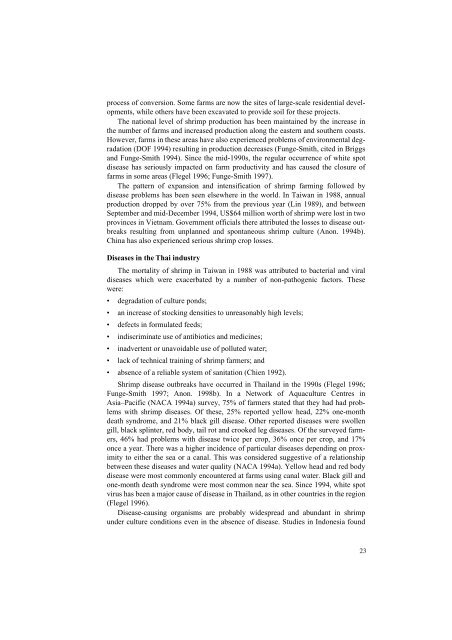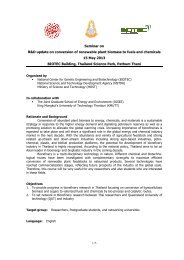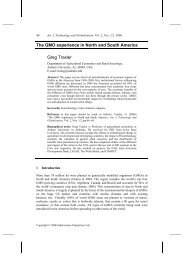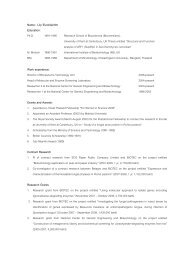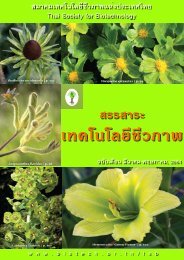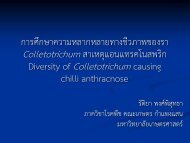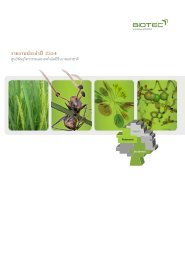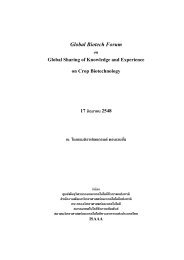!Intensification of farms has been encouraged by DOF as a method of improv<strong>in</strong>gexist<strong>in</strong>g land use. However, this has not always proved possible <strong>in</strong> cases wherefarmers lack technological expertise, have <strong>in</strong>sufficient f<strong>in</strong>ance to make modificationsto their operation, or where the orig<strong>in</strong>al extensive sites are unsuitable (Kapetsky1987; Csavas 1988).Geographic distribution of shrimp aquaculture<strong>Shrimp</strong> farm<strong>in</strong>g is most widespread along the coastal regions of the Gulf of <strong>Thailand</strong>and is currently expand<strong>in</strong>g <strong>in</strong>to areas along the south-western coast adjacent tothe Andaman Sea. Figure 1 shows the ma<strong>in</strong> shrimp farm<strong>in</strong>g areas and the prov<strong>in</strong>cesof <strong>Thailand</strong>. Accord<strong>in</strong>g to Jitsanguan et al. (1993), the first areas to be developed <strong>for</strong><strong>in</strong>tensive shrimp production were the Upper Gulf prov<strong>in</strong>ces of Samut Songhkram,Samut Sakhon and Samut Prakhan, where traditional, extensive farms were replacedby <strong>in</strong>tensive farms. This occurred <strong>in</strong> the mid-1970s and was actively promoted byDOF. By the late 1980s, farmers from this area faced decl<strong>in</strong><strong>in</strong>g production andmoved to the east of the country, particularly to the prov<strong>in</strong>ces of Cholburi, Chantaburiand Trat. In the late 1980s, shrimp farms began to develop on the south-easterncoast. Regions with particularly high farm densities are the prov<strong>in</strong>ces of Nakhon SriThammarat and Songkhla. S<strong>in</strong>ce 1994, these areas have experienced problems, withproduction of farms <strong>in</strong> the southern areas reportedly decl<strong>in</strong><strong>in</strong>g due to disease outbreaks(Anon. 1995a; Flegel 1996; Funge-Smith 1997).In the latter half of the 1990s, most farmers have adopted various strategies <strong>for</strong>disease control to cope with viral diseases, such as white spot and yellow head. Also,farms have been set up <strong>in</strong>land—<strong>in</strong> some cases <strong>in</strong> freshwater areas (Ragunathnan andHambrey 1997).Changes <strong>in</strong> viability of farmsA comb<strong>in</strong>ation of factors has lead to changes <strong>in</strong> productivity and economic viabilityof shrimp farms <strong>in</strong> <strong>Thailand</strong>. In the Upper Gulf <strong>in</strong> the late 1980s, factors <strong>in</strong>cluded:1. Pollution of farm water supplies with water conta<strong>in</strong><strong>in</strong>g the domestic, <strong>in</strong>dustrialand agricultural wastes of the Bangkok area and other areas of the watershed.(The four major rivers that dra<strong>in</strong> <strong>in</strong>to the Upper Gulf are known to be significantlypolluted with such waste, and tidal movements result <strong>in</strong> poor flush<strong>in</strong>g ofthe wastes from the <strong>in</strong>shore areas.)2. Self-pollution of water supplies by the shrimp farms. Where there are high densitiesof <strong>in</strong>tensive farms with <strong>in</strong>adequate separation of source water from effluentwater, the quality of the water <strong>in</strong> the ponds deteriorates, lead<strong>in</strong>g to stress <strong>in</strong> theshrimp and consequently disease.After a peak <strong>in</strong> farm yields <strong>in</strong> 1989, production <strong>in</strong> the Upper Gulf dropped dramatically.Affected areas were Samut Prakhan, Bangkok, Samut Songhkram, SamutSakhon and Petchaburi (Phillips 1992). In Samut Sakhon Prov<strong>in</strong>ce alone, 22,220 raipreviously under <strong>in</strong>tensive culture were abandoned after a deterioration <strong>in</strong> environmentalconditions. Approximately 80% of these farms were idle <strong>in</strong> 1994 (NACA1994a). Many farms were converted back to traditional extensive farms or are <strong>in</strong> the++
!process of conversion. Some farms are now the sites of large-scale residential developments,while others have been excavated to provide soil <strong>for</strong> these projects.The national level of shrimp production has been ma<strong>in</strong>ta<strong>in</strong>ed by the <strong>in</strong>crease <strong>in</strong>the number of farms and <strong>in</strong>creased production along the eastern and southern coasts.However, farms <strong>in</strong> these areas have also experienced problems of environmental degradation(DOF 1994) result<strong>in</strong>g <strong>in</strong> production decreases (Funge-Smith, cited <strong>in</strong> Briggsand Funge-Smith 1994). S<strong>in</strong>ce the mid-1990s, the regular occurrence of white spotdisease has seriously impacted on farm productivity and has caused the closure offarms <strong>in</strong> some areas (Flegel 1996; Funge-Smith 1997).The pattern of expansion and <strong>in</strong>tensification of shrimp farm<strong>in</strong>g followed bydisease problems has been seen elsewhere <strong>in</strong> the world. In Taiwan <strong>in</strong> 1988, annualproduction dropped by over 75% from the previous year (L<strong>in</strong> 1989), and betweenSeptember and mid-December 1994, US$64 million worth of shrimp were lost <strong>in</strong> twoprov<strong>in</strong>ces <strong>in</strong> Vietnam. Government officials there attributed the losses to disease outbreaksresult<strong>in</strong>g from unplanned and spontaneous shrimp culture (Anon. 1994b).Ch<strong>in</strong>a has also experienced serious shrimp crop losses.Diseases <strong>in</strong> the Thai <strong>in</strong>dustryThe mortality of shrimp <strong>in</strong> Taiwan <strong>in</strong> 1988 was attributed to bacterial and viraldiseases which were exacerbated by a number of non-pathogenic factors. Thesewere:• degradation of culture ponds;• an <strong>in</strong>crease of stock<strong>in</strong>g densities to unreasonably high levels;• defects <strong>in</strong> <strong>for</strong>mulated feeds;• <strong>in</strong>discrim<strong>in</strong>ate use of antibiotics and medic<strong>in</strong>es;• <strong>in</strong>advertent or unavoidable use of polluted water;• lack of technical tra<strong>in</strong><strong>in</strong>g of shrimp farmers; and• absence of a reliable system of sanitation (Chien 1992).<strong>Shrimp</strong> disease outbreaks have occurred <strong>in</strong> <strong>Thailand</strong> <strong>in</strong> the 1990s (Flegel 1996;Funge-Smith 1997; Anon. 1998b). In a Network of <strong>Aquaculture</strong> Centres <strong>in</strong>Asia–Pacific (NACA 1994a) survey, 75% of farmers stated that they had had problemswith shrimp diseases. Of these, 25% reported yellow head, 22% one-monthdeath syndrome, and 21% black gill disease. Other reported diseases were swollengill, black spl<strong>in</strong>ter, red body, tail rot and crooked leg diseases. Of the surveyed farmers,46% had problems with disease twice per crop, 36% once per crop, and 17%once a year. There was a higher <strong>in</strong>cidence of particular diseases depend<strong>in</strong>g on proximityto either the sea or a canal. This was considered suggestive of a relationshipbetween these diseases and water quality (NACA 1994a). Yellow head and red bodydisease were most commonly encountered at farms us<strong>in</strong>g canal water. Black gill andone-month death syndrome were most common near the sea. S<strong>in</strong>ce 1994, white spotvirus has been a major cause of disease <strong>in</strong> <strong>Thailand</strong>, as <strong>in</strong> other countries <strong>in</strong> the region(Flegel 1996).Disease-caus<strong>in</strong>g organisms are probably widespread and abundant <strong>in</strong> shrimpunder culture conditions even <strong>in</strong> the absence of disease. Studies <strong>in</strong> Indonesia found+"
- Page 8 and 9: !The 1994 Workshop had a working hy
- Page 11 and 12: !The Workshop at Hat Yai, SongkhlaA
- Page 13 and 14: !ReferenceSmith, P.T., ed.. 1999. T
- Page 15 and 16: !Shrimp Farming in ThailandOver the
- Page 18 and 19: ! !Table 1. World production (# 1,0
- Page 20 and 21: !Domestic and world demandJapan is
- Page 24 and 25: !no significant difference between
- Page 26 and 27: !Production Practices and Technique
- Page 28 and 29: !use water which is almost fresh (F
- Page 30 and 31: !mended quantities for application
- Page 32 and 33: !the biological processes in sedime
- Page 34 and 35: !factors (Fegan 1994). Environmenta
- Page 36 and 37: !Acid sulphate soils occur in most
- Page 38 and 39: during the rainy season, some deter
- Page 40 and 41: Land subsidenceCoastal land subside
- Page 42 and 43: first when an area becomes environm
- Page 44 and 45: !Administration. Their work has inv
- Page 46 and 47: agriculture, selects coastal land p
- Page 48 and 49: Sustainability, Sustainable Develop
- Page 50 and 51: cultural and environmental asset va
- Page 52 and 53: $+Table 12. (cont’d) Impediments
- Page 54 and 55: $#Table 12. (cont’d) Impediments
- Page 56 and 57: $%Table 12. (cont’d) Impediments
- Page 58 and 59: capacities of alternative organisms
- Page 60 and 61: sources. This is one of the greates
- Page 62 and 63: Table 13. (cont’d) Summary of the
- Page 64 and 65: Boonyapiwat, S. 1989. Species of ph
- Page 66 and 67: Katesombun, B. 1992. Aquaculture pr
- Page 68 and 69: Sirisup, S. 1988 Socio-economic cha
- Page 70 and 71: !In the preliminary analysis, the s
- Page 72 and 73:
!until all variables had been teste
- Page 74 and 75:
!quality problem over the past 3 ye
- Page 76 and 77:
!Figure 1. Characterisation of prov
- Page 78 and 79:
!Variables Contributing to Shrimp P
- Page 80 and 81:
!Figure 5. Relationship between ave
- Page 82 and 83:
!southern). The linear regression m
- Page 84 and 85:
!Appendix. Results of logistic regr
- Page 86 and 87:
!2) Trat ProvinceClassification tab
- Page 88 and 89:
!Chi-square df significanceModel Ch
- Page 90 and 91:
!8) Satun ProvinceClassification ta
- Page 92 and 93:
!Variables in the equationConstant
- Page 94 and 95:
!A total of 49 participants were in
- Page 96 and 97:
! ! ! ! ! ! ! ! ! ! ! ! ! ! ! ! !Fi
- Page 98 and 99:
!All issues are listed in Appendice
- Page 100 and 101:
!!were short term and one issue was
- Page 102 and 103:
!reared broodstock (issue 71). They
- Page 104 and 105:
!!Two participants commented that i
- Page 106 and 107:
mation transfer and training. This
- Page 108 and 109:
108Appendix 1. (cont’d) Descripti
- Page 110 and 111:
110Appendix 1. (cont’d) Descripti
- Page 112 and 113:
112Appendix 2. Descriptive statisti
- Page 114 and 115:
114Appendix 2. (cont’d) Descripti
- Page 116 and 117:
116Appendix 3. Descriptive statisti
- Page 118 and 119:
118Appendix 4. Descriptive statisti
- Page 120 and 121:
120Appendix 5. Descriptive statisti
- Page 122 and 123:
Appendix 5. (cont’d) Descriptive
- Page 124 and 125:
Appendix 7. Descriptive statistics
- Page 126 and 127:
Appendix 7. (cont’d) Descriptive
- Page 128 and 129:
128Appendix 8. (cont’d) Descripti
- Page 130 and 131:
!ParticipantsAustraliaDr Paul T. Sm


